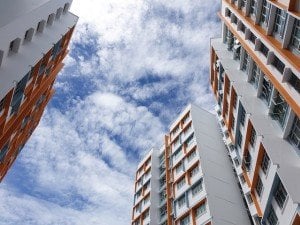IFSEC Insider sits down with Andy Frankum, Chair of the National Social Housing Fire Strategy Group and Executive Director of Health & Safety and Compliance at Concept Housing Association to discuss building safety in 2023 and the importance of fire safety awareness in social housing.
IFSEC Insider (II): Hi Andy, could you tell us about what the National Social Housing Fire Strategy Group (NSHFSG) is?

Andy Frankum, Chair of the NSFHSG
Andy Frankum (AF): The NSHFSG has been established since 2011. Made up of fire safety professionals across the social housing sector, we currently cover England and Wales in eight different regions, which came together after the Lakanal House disaster in 2009. We currently represent about three million homes, and around 237 social housing providers and members, where we’ve got an online community for social housing providers to communicate with each other. We’ve also got regional chairs that heads those groups to have local discussions and to feed information upwards to the national executive.
Partners that work with us on a national level such as the National Fire Chiefs Council, Local Building Authority Control and the National Housing Federation are just a few of the organisations we’ve got sat around the table. The main aim is to share good practice, learn from incidents and influence policy to deliver safer buildings for residents. Since Grenfell, there’s been a renewed focus around where we spend time. Helping to contribute to the work that’s taking place to improve building safety and fire safety.
Currently, there are a lot of considerations around compliance and construction of buildings but fundamentally, our message is we need to keep the fire safety message and awareness alive amongst different sectors, so that we don’t forget the basics and make sure that we can prevent a future disaster.
II: Do you think fire safety is still at the forefront of business’ safety strategies following tragedies such as Grenfell or is this starting to wane?
AF: Let’s not forget that Grenfell was one of the worst disasters we’ve had since the war – we can’t get away from that and that was a wake-up call for lots of people. In terms of business, do I think they are still focusing on fire safety? Absolutely yes.
Compared to where it was 10 years ago, we’ve seen massive strides and changes. I see every day that there’s roles being advertised for fire or building safety managers for example. I also see first-hand how plans are put into place to make sure a building portfolio is navigated correctly in order to manage risk. Fire safety is still a priority.
There is, however, lots of scrutiny around housing associations and safety at the moment, such as damp and mould cases. It’s a reminder that providers have wide-ranging responsibilities and must ensure they are resourcing that correctly, making sure that buildings are safe for residents and working with residents to ensure that. It needs to be a collaborative approach.
II: Speaking of collaboration, what would you say is key to improving organisational culture around fire?

We really need to change the way that we operate, and I think the fire sector is well placed to do that, but it does need support from the construction and housing sectors too. It’s a root and branch change that’s needed, because we need everyone to play their part and be competent.
Something I am very passionate about is competency. Making sure that those responsible for buildings, their staff and workforce are competent and aware of the fire safety issues with buildings. Being able to build confidence all around, as it’s not just the competent fire safety professionals who do a good job every day, it’s about the staff that work in those organisations being confident and aware of building safety as well.
Promote what life safety really means, promote good practice, learn from when things go wrong, but also challenge the status quo.
This will improve the quality in the sector which will naturally raise standards, seeing better results and therefore a more positive outlook within the industry. We need people to do the right thing and ultimately put that as a priority above making profit.
We’re talking about people living in these accommodations and when managing buildings and making sure fire safety is embedded a good thought is, ‘if you put your family in that building, would you be happy with it?’ – if you could do that with your own family then you know you have confidence that the building is as safe as it can be, and that, to me, is the beginning of a positive culture.
II: Would you say then that communication is key to improving culture?
AF: Yes absolutely, communication is really at the heart of it, and trust is right there in the centre as well. We’ve got to put residents in the middle of that and everything we do has to be around making sure we can keep people safe, whether that is in commercial or residential buildings, because when things go wrong it can be devastating.
Occupiers of the buildings are the ones who know what’s going on too. There’s been many times when I’ve walked into a building and knocked on a couple of doors and had conversations with residents where you find out very quickly what’s really happening in the building.
We should have conversations with residents , and not simply assume that we know how to manage their safety. Their involvement also helps to build trust, and they will have confidence knowing that we are looking out for them to make the building as safe as possible.
II: Changes to the Building Safety Regulations were released in January, what impact do you think they will have?

We’ve clearly seen from the Grenfell inquiry that lots of people were following the regulations, but the regulations weren’t sufficient.
We’ve also seen that where we’ve delved into cladding installations, it’s revealed lots of issues with the original install. So, anything that we can do to improve those standards will be beneficial.
It will definitely impact providers. With the cost of living crisis, budgets are getting tighter, the cost of products are on the rise and more difficult to obtain. All those issues create almost a perfect storm, where providers will need to make difficult decisions about how they utilise their resources in the right way to get maximum impact on mitigating the risks for their residents and properties.
There is also a new onus on accountable persons to give residents that voice, we’ve seen that with the social housing reviews as well, not just fire safety regulations, and I’m pleased to see those changes coming into place. We need to share more of that because there are some good things going on.
We also need to make sure those who are not doing their role correctly are appropriately dealt with, which is where the regulator should step in.
II: What fire safety trends or challenges do you think will emerge for 2023?
AF: This year will really be a year of action. There’s a lot of change coming for fire safety professionals, we’ve got the Fire Safety England Regulations that’s come into force with the Grenfell Phase 1 Recommendations being implemented focusing on basic information to residents on fire safety and fire doors.
With the Building Safety Act coming out last April, lots of people will be implementing their plans to make sure that buildings above 18m are managed in line with the new regime.
Then we’ve got the new Building Safety Regulator coming online, with new panels being developed such as the Statutory Resident’s Panel.
So, there’s a lot of good things going on this year, and organisations will see these changes, but will need to make sure that while they are responding to those changes, they also don’t lose sight of the basics: Residents need to be kept safe.
What we don’t want is for people to focus on ‘oh I now need to now inspect a lot more fire doors’ and miss the reason of why they are doing it – are you focusing on your highest risk, are you using your resources to the best effect? Those questions should be at the forefront.
II: Is there an increasing fire safety risk emerging?
AF: With the cost of living crisis, inflation is at a massive high and we’re already starting to see people’s behaviour change, for example, of whether they ‘heat or eat’. That has fire safety implications, such as using candles or opening ovens to keep their flat warm. We should try to encourage safe practice where we can but recognise that will be a huge challenge for us. Raising awareness around these types of issues where we can will be crucial.
A big help will be using data and intelligence to try to prevent fires from happening in the first place. If you have the ability to look at the data you collect, the key is to use that data to best effect and that will help to target where your risks are. Data can give you analysis around what’s happening in the properties or buildings, although you shouldn’t forget about the resident voice which provides insight too – it’s all about how to join those two parts up together.
